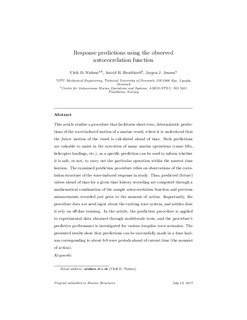| dc.contributor.author | Nielsen, Ulrik Dam | |
| dc.contributor.author | Brodtkorb, Astrid H. | |
| dc.contributor.author | Jensen, Jørgen Juncher | |
| dc.date.accessioned | 2019-01-31T08:22:04Z | |
| dc.date.available | 2019-01-31T08:22:04Z | |
| dc.date.created | 2017-12-12T14:15:33Z | |
| dc.date.issued | 2018 | |
| dc.identifier.citation | Marine Structures. 2018, 58 31-52. | nb_NO |
| dc.identifier.issn | 0951-8339 | |
| dc.identifier.uri | http://hdl.handle.net/11250/2583243 | |
| dc.description.abstract | This article studies a procedure that facilitates short-time, deterministic predictions of the waveinduced motion of a marine vessel, where it is understood that the future motion of the vessel is calculated ahead of time. Such predictions are valuable to assist in the execution of many marine operations (crane lifts, helicopter landings, etc.), as a specific prediction can be used to inform whether it is safe, or not, to carry out the particular operation within the nearest time horizon. The examined prediction procedure relies on observations of the correlation structure of the wave-induced response in study. Thus, predicted (future) values ahead of time for a given time history recording are computed through a mathematical combination of the sample autocorrelation function and previous measurements recorded just prior to the moment of action. Importantly, the procedure does not need input about the exciting wave system, and neither does it rely on off-line training. In the article, the prediction procedure is applied to experimental data obtained through model-scale tests, and the procedure’s predictive performance is investigated for various irregular wave scenarios. The presented results show that predictions can be successfully made in a time horizon corresponding to about 8-9 wave periods ahead of current time (the moment of action). | nb_NO |
| dc.language.iso | eng | nb_NO |
| dc.publisher | Elsevier | nb_NO |
| dc.rights | Attribution-NonCommercial-NoDerivatives 4.0 Internasjonal | * |
| dc.rights.uri | http://creativecommons.org/licenses/by-nc-nd/4.0/deed.no | * |
| dc.title | Response predictions using the observed autocorrelation function | nb_NO |
| dc.title.alternative | Response predictions using the observed autocorrelation function | nb_NO |
| dc.type | Journal article | nb_NO |
| dc.type | Peer reviewed | nb_NO |
| dc.description.version | acceptedVersion | nb_NO |
| dc.source.pagenumber | 31-52 | nb_NO |
| dc.source.volume | 58 | nb_NO |
| dc.source.journal | Marine Structures | nb_NO |
| dc.identifier.doi | 10.1016/j.marstruc.2017.10.012 | |
| dc.identifier.cristin | 1526316 | |
| dc.relation.project | Norges forskningsråd: 223254 | nb_NO |
| dc.description.localcode | © 2018. This is the authors’ accepted and refereed manuscript to the article. Locked until 21.11.2019 due to copyright restrictions. This manuscript version is made available under the CC-BY-NC-ND 4.0 license http://creativecommons.org/licenses/by-nc-nd/4.0/ | nb_NO |
| cristin.unitcode | 194,64,20,0 | |
| cristin.unitname | Institutt for marin teknikk | |
| cristin.ispublished | true | |
| cristin.fulltext | preprint | |
| cristin.qualitycode | 2 | |

